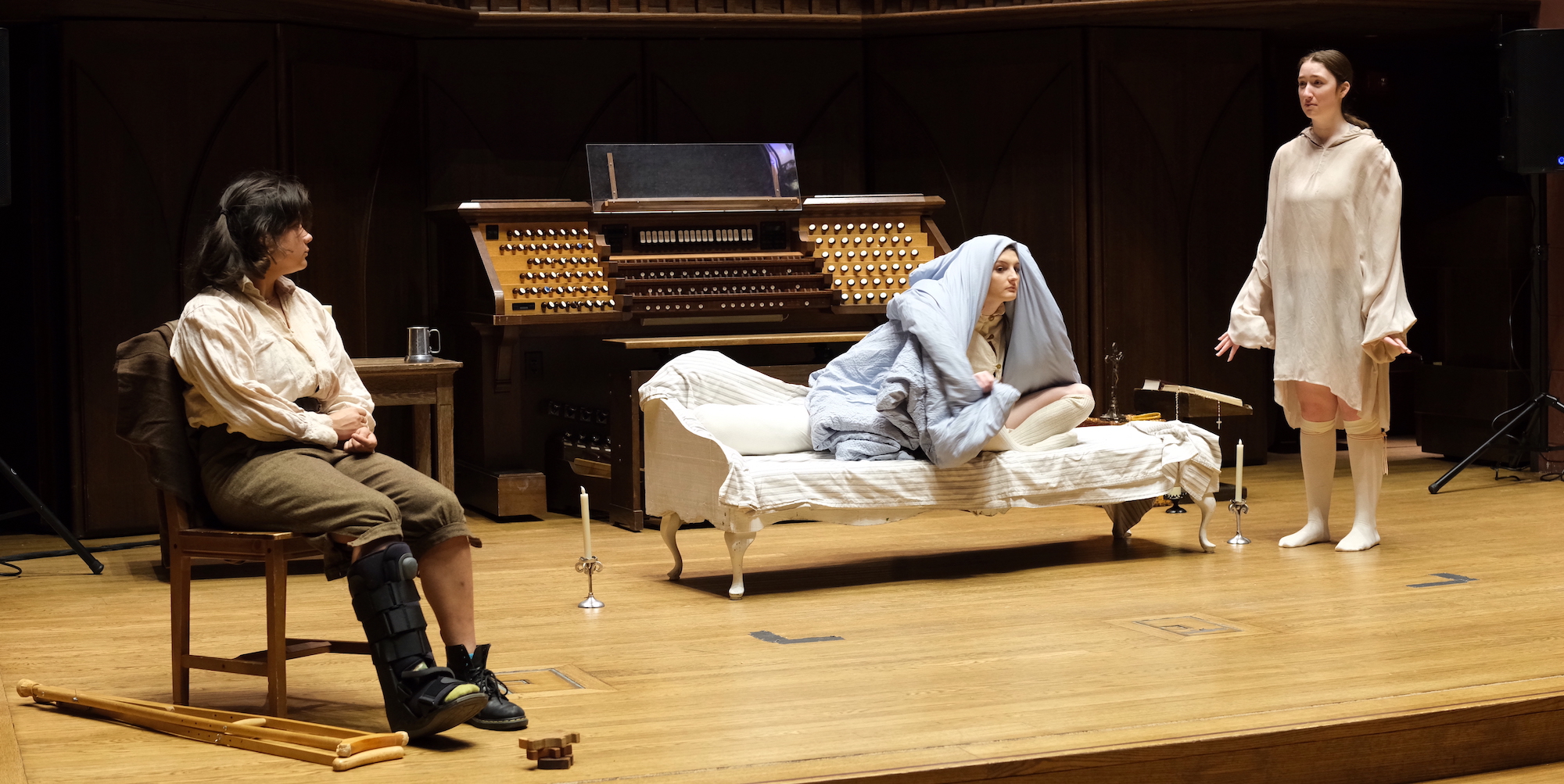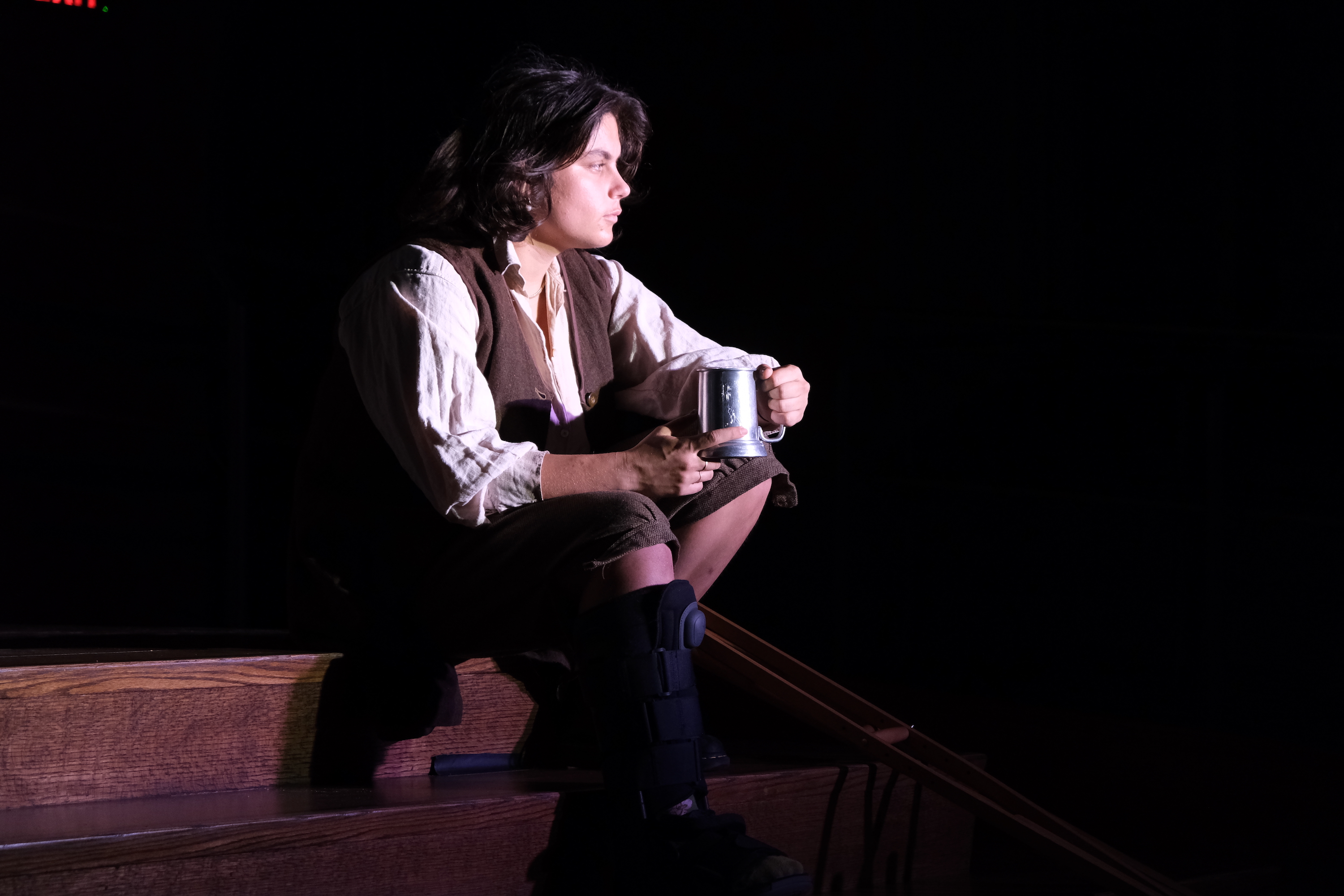
“The Boys in the Tower,” an original play written by Jaydie Halperin ’23 and directed by Sabrina Ladiwala ’24, was performed in Memorial Chapel on Friday, Nov. 18 at 8 p.m. and Saturday, Nov. 19 at 2 p.m., 4:30 p.m., and 8 p.m.. The play follows brothers Neddy (Molly Volker ’26) and Duckie (Bailee Gull ’24), two young princes in fifteenth-century England who have been imprisoned in the Tower of London, supposedly to protect them until Neddy can be crowned king. However, when the boys receive an unexpected visitor, known initially as The Boy (Kyra Kushner ’24), they are faced with a decision that forces them to test their brotherly bond, weigh their desire for freedom, and question who they can trust.
The plot of “The Boys in the Tower” is roughly based on the real history of the princes in the tower, Edward V of England and Richard of Shrewsbury, Duke of York. When they were 12 years old and nine years old respectively, their uncle, the Duke of Gloucester, lodged the brothers in the Tower of London. The princes were the only sons of King Edward IV and Elizabeth Woodville, making them the only heirs to the throne upon their father’s death. Amid the political turmoil surrounding who would be the king’s successor and the ongoing War of the Roses, the princes’ uncle took the throne as King Richard III. Though it is suspected that the boys were killed, it is ultimately unknown what became of them.
After learning about the princes, Halperin was inspired to write “The Boys in the Tower.” She was intrigued by the many unknown elements of the story and wanted to explore the many possible fates that could have befallen the boys.

“I thought it was so compelling [to ask] what happened to these people that just kind of disappeared from history,” Halperin said. “Why did their uncle usurp them? Who killed them, and when?… I’m just really interested in solving that mystery without actually solving the ultimate mystery of what happened to them.”
Despite many historical similarities, Halperin also took some creative liberties with the script to raise the stakes and heighten the drama. For example, the princes were never actually greeted by a strange boy. The Boy’s suspicious arrival in “The Boys in the Tower” adds further suspense to the mystery enshrouding the princes’ reality. The Boy, claiming to be an ally, brings a note to the princes stating that the brothers will be killed soon, and that The Boy is to replace Neddy so that he can escape and be crowned king. However, this requires the princes to abandon each other, which neither wants to do.
“In the play, the boys are really close…but in real life…they probably only saw each other once [or] twice a year,” Halperin said. “But that’s not as compelling as people who are very close together…. It’s pretty similar, but…there’s only so much drama you can milk out of historical sources. You just gotta add some of your own drama.”
Though the boys are torn by the decision about how to handle their impending death and the chance of one’s escape, Neddy eventually decides that he is willing to sacrifice his life for Duckie’s survival. Duckie reluctantly leaves the tower through Memorial Chapel’s stage right exit, which was backlit with an ominous orange that cast him in a suspicious shadow.
The lighting in “The Boys in the Tower” (designed by Sophia Flynn ’25) was incredibly effective, from this fiery, dangerous orange light to the moody purple that suggested a window to the outside world, and the soft blue that signaled each day’s end. During these transitions, the world of “The Boys in the Tower” was further enhanced through live piano accompaniment (composed and performed by Oluchi Chukwuemeka ’26). These interludes, which carefully matched the scenes in intensity and mood, captivated me and immersed me in the story.
At Duckie’s prompting, The Boy reveals that his real name is George—the same name as the princes’ brother who passed away—and that he was sent by someone wearing a red flower. This is alarming to Neddy, who is from the House of York—whose sigil is a white flower—and therefore is wary of any person claiming to be his ally yet wearing the opposing flower. Neddy is struck with the realization that he has been tricked; George was sent by an enemy as a way to lure the young heir to his death, and Neddy has inadvertently sent his brother to die.
Upon piecing together this puzzle, the grim reality becomes visible on Volker’s face when she breaks down. Seeing the sudden understanding overcome her was striking, and brought the pain present in the scene to life, soliciting my sympathy. All three actors delivered incredible performance: Gull’s childlike, playful energy and Kushner’s trepid innocence created compelling dynamics between the three that further brought me into their world, and heightened my anxiety about their final fate.
The actors’ performance became more impressive when Ladiwala told me that the three had overcome many obstacles in the process of putting up the show. Ladiwala herself as well as two actors were injured in the weeks preceding the show, so they had to rework blocking to minimize the actors’ movement and reconsider how they would utilize their performance space. Ladiwala explained that in reblocking, the team discovered new layers to the characters, which ended up being a silver lining to the injuries.
“There was one moment in the show that was originally going to be one of the characters freaking out and melting onto the ground, but due to her injury that wasn’t actually possible,” Ladiwala said. “So we ended up just having her stand still and be almost frozen in fear. And that really evoked a totally different response for the end of that scene, which was a cool choice and I really loved that.”

In the end, Duckie returns to the tower, frightened yet unharmed. The princes agree that they will never separate again, and send George out to impersonate Neddy and reclaim the throne. Though this appears to be a happy ending, in the play’s final moments a startling knock on the door resonates throughout the audience. The boys and the audience are unsure who it could be, as historians are unsure what the brothers’ eventual fate was.
“I’m really excited to have the audience members see scene five, which is where everything culminates, and you maybe get an answer, maybe you don’t,” Ladiwala said. “It’s interesting to see also in scene five, the dynamics between all three characters have changed…. By the end, The Boy becomes one of them and they become friends. To see that change and to feel that warmth on stage is lovely.”
The foreboding ending of “The Boys in Tower” left me with a handful of answers and an abundance of questions, which still haunt me weeks after seeing the show. Halperin’s modern rendition of this medieval tale was intense, heart-wrenching, enthralling, and had me on the edge of my seat for the entire show. Though it was likely that the princes were killed in all actuality, they live on through “The Boys in the Tower.”
Sabrina Ladiwala is an Arts & Culture Editor for The Argus.
Kat Struhar can be reached at kstruhar@wesleyan.edu.


Leave a Reply